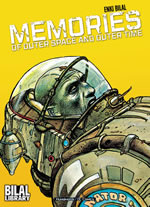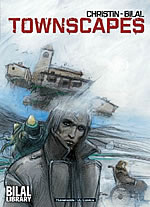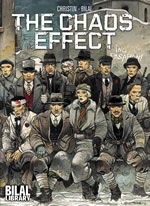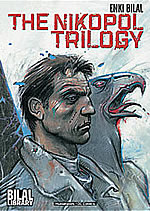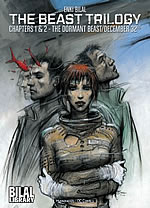Enki Bilal:
Immortal For Life
"Perhaps it’s my past that makes me restless, makes me want to keep moving." The son of a Bosnian father and a Czech mother, Enki Bilal spent his first nine years in Belgrade, in the former Yugoslavia, a country in the shadows of communism and still struggling in the aftermath of the Second World War.
Ever since he was young, Bilal had a passion for comics and for the big screen, going every week to the movies, especially his favourites, westerns.
When he was nine, he landed a part in a short film being made in Belgrade. "It was about two street kids wandering around the city. They would stop and sketch out fights in chalk on the pavements, one drawing cowboys, the other Indians. Being a budding actor suddenly expanded my universe." He was a budding cartoonist too, but as luck would have it, he had to leave his homeland before the film was completed. He never found out what happened to it, after he and his family left the troubled city and resettled in 1961 in Paris.
For him, France was a new life, and a new culture, of the cinema and of comics or bande dessinées. In the early 1970s he found his first calling as a BD artist, when he won a talent competition for the magazine Pilote, home since 1959 of Asterix and at the time the cutting edge of the dawning BD revolution. Here, and later in Metal Hurlant, Bilal began to write and draw a series of short SF stories, two books of which have just been collected into one volume of Memories, the latest in the good value Bilal Library collections from Humanoids and DC Comics.
His most important collaborator at Pilote was renowned writer Pierre Christin. Together they developed a trilogy of contemporary tales of the fantastic, partly social satires, partly chillers inspired by HP Lovecraft, set in different present-day cities beset by mysterious forces. These three formative stories are compiled in Townscapes.
Espionage, regime change, terrorism and resistance were ingredient in Bilal and Christin’s later, more politically charged projects, The Black Order Brigade and The Hunting Party are combined in the book The Chaos Effect. Bilal’s art evolved a greater sophistication, as he moved away from detailed linework towards more fully painted rendering and a richer colour palette.

Bilal made his greatest break-through in comics when he went solo on his first full-length graphic novel Gods In Chaos in 1980. Alcide Nikopol is a man who fell to earth, after orbiting in suspended animation, imprisoned in space for desertion. His miserable mortal life alters radically, when he is revived in Paris, injured but unchanged 20 years later in a world where everyone else has aged. His missing leg is replaced with a metal graft welded by Horus, a naked, falcon-headed alien renegade, who looks like his namesake, the Egyptian god.
Nikopol can no longer call his life or body his own, because Horus needs to possess him to act as his instrument of revenge against his fellow gods, hovering in their pyramid spacecraft above Paris. Global power politics have devolved into a bizarre circus. Inside the body of Nikopol, Horus infiltrates the chambers of the painted governor Choublanc (French for loser) and seizes power in the French capital. Nikopol discovers that his wife , now dead, had a son, now the same age as him and virtually his twin.
Bilal returned to the saga in 1986 with The Woman Trap, introducing the exotic femme fatale Jill Bioskop (the Serb word for cinema), a blue-haired reporter of the future with blood on her hands. He eventually completed the saga in 1992 in Cold Equator. Bilal’s visions reveal a decadent dystopia, overwhelming and baroque, inspired by directors like Andrei Tarkowsky of Solaris and Stalker. His plotting is dense, unpredictable, and really repays close attention. There is also a dark, absurdist humour, from the freakish make-up of politicians and the stripped alien cat Gogol to the world chess-boxing championships.

In all, The Nikopol Trilogy took Bilal twelve years to complete, while he pursued his other great obsession and eventual career, film-making. An important break came from Alain Resnais, a great admirer, who gave him the chance to design the poster and some painted glass sets for his films. Another opportunity came in 1983, when director Michael Mann was shooting The Keep. Unhappy with the look of the monster, he hired Bilal, because he was familiar with his albums.
Bilal learnt from Mann that all the albums by French BD artists like Druillet, Moebius, Mézières and himself had been lying around in every American film studio. They had been copying them for years. It’s no big secret that George Lucas was heavily influenced in Star Wars by the Valerian albums (iBooks) written by Christin and drawn by Mézières, from the look of the Millennium Falcon to the alien bar scene. Moebius and Dan O’Bannon has essentially created much of the mood and style of Blade Runner in their collaboration The Long Tomorrow years earlier.
Fortunately, directors did start to commission these visionary artists to contribute officially to productions. Bilal was hired to produce preparatory drawings for The Name Of The Rose, for example. With guidance from Resnais, Bilal went on to direct his first film in 1988, Bunker Palace Hotel, routed in the same sensuous decadent future of his graphic novels. After making his second feature Tykho Moon, Bilal directed his third film in 2004, his most ambitious and big-budget yet. Immortel Ad Vivam, or Immortal For Life, reinterprets parts of The Nikopol Trilogy and combines live action with blue-screen digital imagery based on his artwork, for the stunningly realised decors, cityscapes and the alien characters, including the alien Egyptian gods.

The film received praise and performed well in France, when it came out. It should have made Bilal’s name internationally, and in English especially. Sadly, apart from some festival screenings and a limited Canadian release, it has so far failed to get any proper cinematic general release in the UK or USA. It’s tough to compete with the massive Hollywood machine. Immortel is already out on DVD, but really deserves to be seen in the cinema. Visit Immortel-Le Film to sample the trailer and more.
Back to BD, Bilal’s most recent magnum opus is The Beast Trilogy, a luscious, challenging psycho-drama about a man with total recall. This came out in 2004 in collected form in the first trilogy that I’ve ever seen with only the first two parts in it, The Dormant Beast and December 32. Frustrating, but it will have to do for now, while we wait for him to finish the final part.
Knowing Bilal’s restless nature, it won’t be long before he is drawn back to his passion for creating comics once again.

The original version of this article appeared in 2005 in the pages of Comics International, the UK’s leading magazine about graphic novels, comics and manga.













